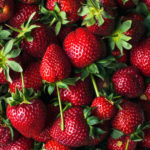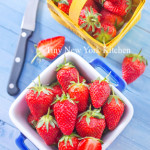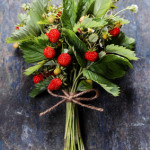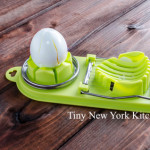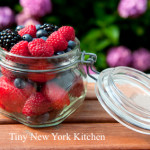Though they are available year-round in grocery stores the best strawberries are to be found in farmer’s markets in spring and early summer.
Look for smaller berries, preferably organic ones, with a rich, glossy red color and shiny green leaves. Avoid berries with white or green shoulders and brown or limp leaves. Never buy them if they are moist, overly soft or show signs of mold. Do not buy berries if their cartons are leaking and wet, a sure sign that unseen fruits will be moldy.
Although fresh strawberries should be rinsed, do not soak them for any length of time since they will absorb the water and turns mushy. For eating on their own, strawberries, even very large ones, should be left whole. Hull strawberries before freezing them or using them for most preparations. Use a small paring knife or a strawberry huller to carve out the white center core from the stem end of each berry. To improve the flavor of lackluster strawberries, hull and slice them, place in a bowl and sprinkle with a tablespoon or two of sugar for every pint. Let stand at room temperature for at least 15 minutes. The sugar draws moisture from the berries to make a sweet natural syrup.
Fresh strawberries are fragile so handle them with care. Don’t wash the berries until just before you are ready to eat them, as the moisture will encourage mold. To store strawberries, line a glass or plastic container with paper towels, carefully arrange the berries inside and cover with the lid. They will keep in the refrigerator for up to 1 week.
©Tiny New York Kitchen © 2021 All Rights Reserved
These freezer essentials will help you with your weekly meal prep as well as last minute meals that you need to get on the table fast.
Bagged frozen vegetables, like mixed peppers, broccoli, and spinach.
Bagged frozen fruit, like blueberries, mangos, bananas, and strawberries.
Bagged frozen pastas, like tortellini and ravioli.
Frozen waffles and pancakes.
Frozen potatoes, like tots, fries, and breakfast potatoes.
Rice and prepared side dishes.
Pre-made dough, pie crusts, and breads.
Frozen foods are not limited to frozen dinners. You can stock your freezer with healthier ingredients to make putting dinner together easy. There are endless possibilities with what you can make with frozen ingredients. As always, be creative and “work with what you got!”
“Work With What You Got!”
©Tiny New York Kitchen © 2020 All Rights Reserved
Scones are made in one bowl and are practically foolproof, so they’re great for beginners. Use parchment paper to line baking sheets for easy cleanup.
“Work With What You Got!”
©Tiny New York Kitchen © 2019 All Rights Reserved
Juicy berries are bursting with flavor and now is the perfect time to pick them up, whether for snacking or adding to sweet and savory recipes.
Make sure to look for bright, shiny strawberries, and skip any that are smashed, shriveled, or moldy. Their color should be deep and even, with no white or green patches, and they should smell fragrant.
Wait to wash them. Water increases the risk of mold, so leave berries in their original packaging and rinse in cold running water just before serving. Their shelf life is short, so serve or cook berries within 2 to 3 days.
Despite their sweetness, strawberries are relatively low in sugar. They also provide fiber, antioxidants, and vitamin C. In fact, strawberries contain more vitamin C per serving than oranges!
“Work With What You Got!”
©Tiny New York Kitchen © 2019 All Rights Reserved
We love autumn, but we’re giving it one last-ditch effort to savor the remaining glimmers of summer. You may frost this cake or leave it plain.
Ice Tea or Iced Tea? It depends on where you live. In the South, it’s called ice tea and everywhere else it’s called iced tea.
Iced tea did not take its current form until the popularity of black tea took off, thanks to the work of the Indian Tea Commission at the St. Louis World’s Fair in 1904. As the legend goes, Richard Blechynden, the head of the commission, watched the fairgoers pass by his elaborate teahouse as the sweltering temperatures made hot beverages unpalatable. Driven to increase the market for Indian black tea in the States, he hit upon the idea of not only serving it iced, but also perhaps more importantly, giving it away for free. His booth was soon the most popular at the fair as the patrons found his golden beverage to be the perfect refreshment.
Spurred on by his success in St. Louis, Blechynden toured the country, giving away more and more iced tea, quickly spreading its popularity nationwide. Brewing the perfect iced tea at home, complete with sweet and often fruity syrups, soon became the hallmark of a great hostess. Iced tea was mixed with all sorts of flavors in delicious punches; lemon, mint, strawberries, cherries, and oranges, whether fresh, preserved, or in syrup form or, for the more mature palette, brandy and bourbon to give it a little extra kick. And though few still have time for such an elaborate and time-consuming production (early recipes recommend beginning to brew tea at breakfast for service at dinner), iced tea remains an American favorite, available in bottles, cans, and even from a soda fountain.
To make iced tea use double the amount of tea or teabags that you would use for hot tea when you’re planning to chill the drink. And allow the tea to come to room temperature before you put it into the refrigerator. Fill an ice cube tray with tepid tea and freeze for ice that won’t dilute your drink. You could also float some minced mint or fruit in the cubes for a special treat.
“Work With What You Got!”
© Victoria Hart Glavin Tiny New York Kitchen © 2017 All Rights Reserved
Strawberries are the irresistible taste of spring. They’re juicy, refreshing, great for pies, excellent for picnics, and perfectly in season.
Strawberries aren’t truly berries, because of their seeds that are on the outside. An average strawberry has approximately 200 seeds. If you don’t want the seeds on your strawberries, you can gently peel off the outside with a paring knife.
Strawberries are known for sweet jams and tarts, but they are an excellent base for savory recipes as well, like spicy salsas, glazes for meats, and endless fresh green combinations in strawberry salads.
Ounce for ounce, strawberries have more vitamin C than an orange. They are also full of antioxidants. Consuming a serving a day (about 1 cup of sliced strawberries) will even boost your immune system. These same qualities make strawberries a great exfoliating face mask. Just mash 9 strawberries, mix in 2 tablespoons of honey, and apply over your face (avoid your eyes). Wash away the mask after 10 minutes and your skin will shine.
It’s so disappointing to buy strawberries and they end up having no flavor. Here are ways that you can tell if you’re buying the best strawberries.
The Smell Test! Strawberries that are ready for eating have a sweet, delicious scent.
Color Check! Look for a bright red color. That’s the best indication of flavor. A strawberry with too much white was not picked in its prime.
Bottoms Up! Most of the strawberries are hidden in the box interior. Check the bottom of the box will let you see if there are small pools of juice leaking and if any strawberries have been squashed.
After you’ve brought home your delicious strawberries make sure to keep them dry. Don’t wash them until just before you’re ready to use them. This will keep them lasting longer.
When hulling strawberries you may want to give this trick a try. Instead of chopping off the whole leafy top of a strawberry, poke a drinking straw into the bottom of the strawberry and push it all the way through to the other side, until the top pops off, or use a paring knife or teaspoon to scoop out just the green.
“Work With What You Got!”
© Victoria Hart Glavin Tiny New York Kitchen © 2017 All Rights Reserved
Making precise slices of softer, smaller foods in a snap, literally, with this tool designed to hold slippery, hard-cooked eggs in its cradle as the wires cut through. Cleanup is just as speedy – use a kitchen brush and warm, soapy water.
It can quick slice soft fruits and vegetables such as peeled kiwis, hulled strawberries, white or cremini mushrooms, and pitted olives.
Create perfect rounds from soft cheeses, like fresh mozzarella balls and goat cheese.
Make even pats from a stick of butter.
Be creative and try using an egg slicer on soft foods that you’re preparing. The possibilities are endless.
“Work With What You Got!”
© Victoria Hart Glavin Tiny New York Kitchen © 2017 All Rights Reserved
Care & Handling Of Berries
Strawberries: Pick strawberries at their peak of ripeness. Look for symmetrically shaped berries; a brilliant sheen and rich even red color; fresh unwilted green caps; avoid strawberries with seedy tips or white shoulders. A white “core” in your strawberries is not an indication of ripeness. The internal pigment of strawberries ranges from white to bright red and is a characteristic of the berry plant variety and not of the berries’ ripeness or flavor.
Raspberries: When choosing raspberries look for plump, evenly colored berries that have a soft and hazy gloss and are free of dents and bruises. Raspberries have tiny hairs on them called “styles.” These are a completely natural part of the fruit’s defense mechanism and do not affect the taste or ripeness of the berries.
Blueberries: Choose blueberries that are dry, plump, round and free of dents and bruises. Blueberries should have a soft , hazy white coating, which is called “bloom.” Bloom is a completely natural part of the berries’ defense mechanism and helps protect them from the harsh rays of the sun. Avoid blueberries that are shriveled or lack bloom.
Blackberries: Look for deep, evenly colored blackberries with a nice sheen. Berries that are plump and dry and free of dents or bruises. Blackberries range in color from deep blue/purple to deep purple/black. Blackberries are often two-tone in color, which is perfectly natural and does not affect ripeness.
All fresh berries are highly perishable and should be refrigerated at all times until eaten or used as an ingredient. Refrigeration will extend freshness and shelf life.
It is recommended that you wash all berries before using them. However, you should never wash your berries until just before you are ready to eat or use them, as the moisture will decrease their shelf life.
Fresh berries can be easily frozen and enjoyed until you are ready to use them.
Wash strawberries carefully in cold water and pat dry. Remove the stems and any soft spots. Pack the berries into freezable containers or freeze them on a baking sheet and then pack them into containers as soon as they are frozen. Seal containers and keep frozen until you are ready to use them.
Raspberries and blackberries are very fragile and fresh raspberries are very sensitive to freeze damage. To freeze raspberries and blackberries rinse them gently in cool water then allow them to dry in a colander or on paper towels. Place a sheet of wax paper on a baking sheet then place berries in freezer. After berries are frozen, pack them into sealed containers until you are ready to use them. By freezing the berries this way, they won’t stick to each other which allows you to easily measure out the needed amount once you are ready to use them.
If you plan to freeze your blueberries, do not wash them before freezing as doing so will make the blueberry skins tough. Instead pack your blueberries into freezable containers, or freeze them on a baking sheet and then pack the into containers as soon as they are frozen. Seal the container and keep frozen until you are ready to use them. Be sure to wash the thawed blueberries prior to use.
Berries are delicious, nutritious, disease-fighting fruits. With their high antioxidant levels, berries are also considered “superfoods” because their health benefits may help the body fight off disease and slow the effect of aging. Berries are also high in vitamins and low in calories so they are a perfect fruit to include in your daily diet.
Antioxidants are natural substances found in plants, which are known, to aide in the prevention of heart disease, cancer and strokes. They provide protection by neutralizing free radicals, which are substances that form when oxygen is burned by the body. Free radicals travel through cells, disrupting the structure of other molecules, causing cellular damage. This cell damage is believed to contribute to aging and various health problems. In addition to boosting your immune system, antioxidants have been found to slow the effects of aging by improving memory, balance, coordination and motor skills. Berries are some o the most delicious and powerful disease-fighting foods available. Considered “superfoods,” antioxidant levels in berries are measured by their ORAC (Oxygen Radical Absorbance Capacity) Value.
“Work With What You Got!”
© Victoria Hart Glavin Tiny New York Kitchen © 2016 All Rights Reserved

